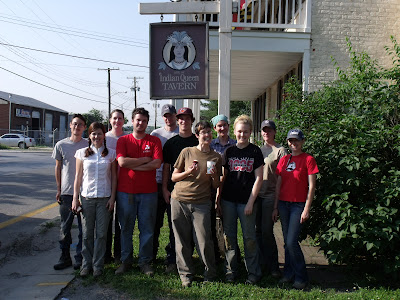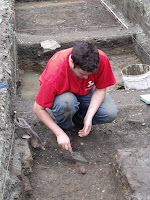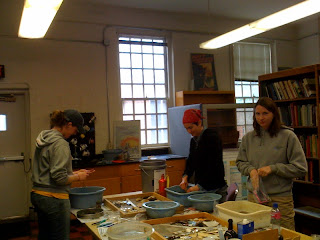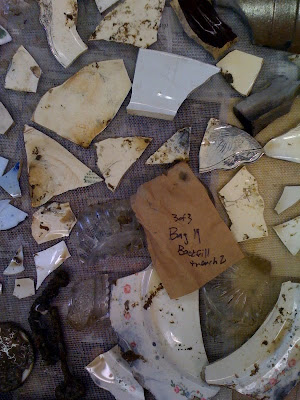 It was our last day in the field at the Indian Queen Tavern Site, though some of us will be back here in late June to finish up a few things....
It was our last day in the field at the Indian Queen Tavern Site, though some of us will be back here in late June to finish up a few things....Meanwhile all the archaeologists that joined the excavation have different projects to work on through the summer: some are off to digs in Scotland at a castle, or at a 19th century plantation in Maryland, or at a quarry in Frederick, and to Belize. Some are off to work on the cultural resources outreach for the ICC, some to help the National Park Sevice catalog the material culture for the Vietnam Veteran's Memorial or organize the civic engagement program for the Nations Park's. I am looking forward to hearing about all their summer adventures!
Here is a posting from Jenna Zimmerman, a graduate student at the University of Maryland, talking about what she learned out at the site:
The past two weeks here in Bladensburg have certainly been an adventure – rain, blistering heat, incredible artifacts, amazing people, and of course many sore muscles. Although I’ve worked on multiple archaeological excavations over the past three years, I always find that every site is different – new people, new artifacts, new information about the past, new methods of archaeology, and even new lessons on archaeology. As a student of archaeology, I am constantly looking to learn something when I step onto a new field site, and Bladensburg has been nothing short of a learning experience. On my first day alone, while working with Jenn, I had to learn an entirely new way of filling out paperwork. For all the non-archaeologists out there, you may not realize that everything you do in the field must get written down – measurements for every layer you dig, the number and types of artifacts you find, the types of soil you are digging in, etc.
This week I have spent a lot of time wet-screening, which may have left me covered in mud at the end of each day, but was well worth it during the heat we experienced over the past two days. While working in Unit 7 with Lisa and Zac, we kept gradually approaching the water table and all of our soil got sludgy and mixed with clay, which required a lot of water-screening. Digging in this unit also proved difficult because it was difficult to see the various changes in the soil. We discovered a feature ( Feature 31) that gradually got wider as we dug deeper. Lisa hypothesized that this could have been a builder’s trench as it was located next to a possible stone wall. Artifacts that came out of this feature included a variety of ceramics, buttons made of metal and glass, and a glass goblet.
I have certainly enjoyed my time working here in Bladensburg, and I am sad that is coming to a close today. The team of archaeologists working here undoubtedly has a wealth of knowledge about all historical artifacts, and I will carry this knowledge with me to my next field site this summer. I would like to thank all of the archaeologists and volunteers who worked at the site – all of you made this excavation not only educational, but also interesting and enjoyable!
This week I have spent a lot of time wet-screening, which may have left me covered in mud at the end of each day, but was well worth it during the heat we experienced over the past two days. While working in Unit 7 with Lisa and Zac, we kept gradually approaching the water table and all of our soil got sludgy and mixed with clay, which required a lot of water-screening. Digging in this unit also proved difficult because it was difficult to see the various changes in the soil. We discovered a feature ( Feature 31) that gradually got wider as we dug deeper. Lisa hypothesized that this could have been a builder’s trench as it was located next to a possible stone wall. Artifacts that came out of this feature included a variety of ceramics, buttons made of metal and glass, and a glass goblet.
I have certainly enjoyed my time working here in Bladensburg, and I am sad that is coming to a close today. The team of archaeologists working here undoubtedly has a wealth of knowledge about all historical artifacts, and I will carry this knowledge with me to my next field site this summer. I would like to thank all of the archaeologists and volunteers who worked at the site – all of you made this excavation not only educational, but also interesting and enjoyable!
AND BTW!
We'll have lots more to say as we start to look at the tremendous assemblage of artifacts we collected over the last two weeks. We also have video and photos from the field to sort through as we organize documentation from ten test units, thirty archaeological features and thousands and thousands of artifacts. We'll also talk about other aspects of Bladensburg history we have come across that relate to our projects in town. We are also planning a fourth workshop at the George Washington House early this Fall to talk about the archaeology and history of Bladensburg. So stay tuned!
This morning we had a visit from Bladensburg Mayor Walter James. For those of you who have been following us over the year, you might remember Mayor James helped us out at the Market Master's House excavation last spring and wrote a blog post: (http://bladenarch.blogspot.com/2009/06/day-9-very-special-guest-field-tech-and.html).
Here are a couple of photos from this morning's visit. Thanks again for visiting, Mayor James!








 Posted by Molly Russell, graduate student from the University of Maryland, Department of Anthropology:
Posted by Molly Russell, graduate student from the University of Maryland, Department of Anthropology: That could possibly help explain the mystery of the amorphous post hole. These 19th century artifacts may have been part of a later intrusion that cut into the initial 18th century post hole. Only time (and more digging!) will tell if this theory is correct.
That could possibly help explain the mystery of the amorphous post hole. These 19th century artifacts may have been part of a later intrusion that cut into the initial 18th century post hole. Only time (and more digging!) will tell if this theory is correct.


 that might be related to a cabinet/ coffinmaker that occupied the lot (more on that in an upcoming blog post!). Finally down at the bottom of the trench we found the kinds of ceramics that definitely identify the mid to late 18th century including white salt-glazed stoneware and scratch blue.
that might be related to a cabinet/ coffinmaker that occupied the lot (more on that in an upcoming blog post!). Finally down at the bottom of the trench we found the kinds of ceramics that definitely identify the mid to late 18th century including white salt-glazed stoneware and scratch blue.  At the moment the weather is looking up for tomorrow. We are hoping to get a great start on four test units placed along the length of our first trench, and excavate a second trench parallel with our first one. Our team will expand to a group of nine. More to come tomorrow!
At the moment the weather is looking up for tomorrow. We are hoping to get a great start on four test units placed along the length of our first trench, and excavate a second trench parallel with our first one. Our team will expand to a group of nine. More to come tomorrow!


